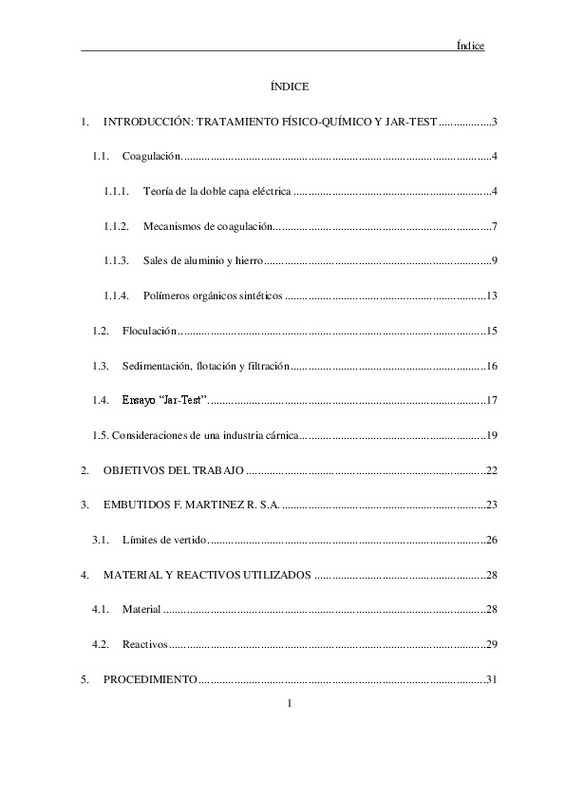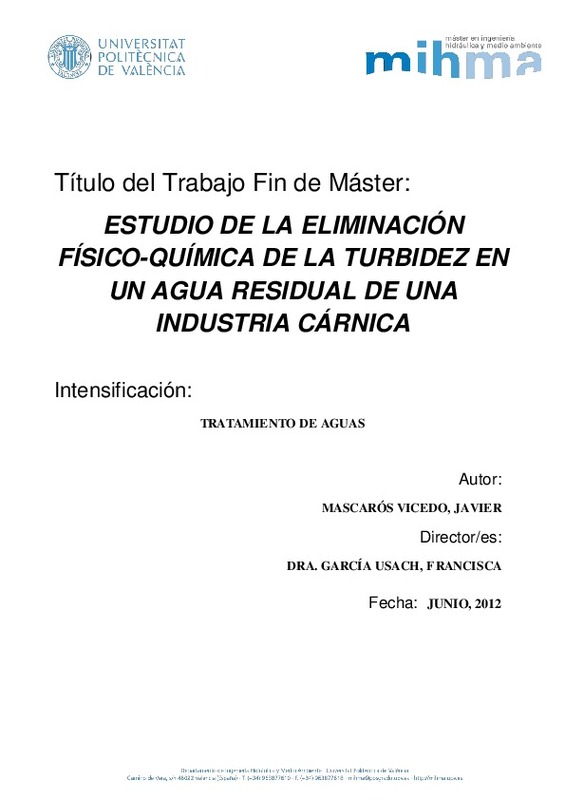|
Resumen:
|
[ES] Por lo general, el sector industrial necesita de cantidades ingentes de agua para el desarrollo de todas sus actividades productivas. Debido a la carga contaminante que adopta el flujo de agua en el proceso industrial, ...[+]
[ES] Por lo general, el sector industrial necesita de cantidades ingentes de agua para el desarrollo de todas sus actividades productivas. Debido a la carga contaminante que adopta el flujo de agua en el proceso industrial, el grado de impacto sobre la salud humana y el medio ambiente termina siendo muy preocupante. Es por ello que urge la necesidad de tratar el agua residual antes de ser vertida a cualquier medio receptor. El tratamiento común que se emplea en la depuración de agua residual industrial, en el caso de estudio, agua residual cárnica, es el físico-químico. Para hacerlo efectivo, se realiza primeramente ensayos "Jar-Test" en laboratorio, favoreciendo los procesos de coagulación, floculación y sedimentación con el fin de establecer las condiciones del estudio y las dosificaciones óptimas de los reactivos. En el presente estudio, se valoraron cuatro alternativas de tratamiento (coagulante + floculante) mediante ensayos "Jar-Test". Se dispuso de un neutralizante, dos coagulantes y dos floculantes, y se estudió la mejor combinación en base al incremento de conductividad experimentada, la generación de fango, el porcentaje de turbidez eliminada y el coste total del tratamiento. Se prestó mayor atención al porcentaje de turbidez eliminada para cumplir los límites de vertido, y a la generación de fango, ya que ésta última supuso un porcentaje muy importante del coste final. Además se realizaron varias comparativas entre los coagulantes y floculantes con el fin de establecer la efectividad de cada uno de ellos sobre los parámetros estudiados. Finalmente, en base a los resultados obtenidos y a la elección de la alternativa óptima de tratamiento, se propuso el diseño de una instalación industrial consistiendo en el depósito de mezcla para el polielectrolito, la preparación del coagulante, la cámara de floculación y el decantador.
[-]
[EN] In general, the industry sector needs massive amount of water to develop all its productive activities. Due to the pollutant load the water flow gets during the industrial process, the degree of impact on human health ...[+]
[EN] In general, the industry sector needs massive amount of water to develop all its productive activities. Due to the pollutant load the water flow gets during the industrial process, the degree of impact on human health and environment ends up being a worrying. That¿s why there is an urgent need to treat the wastewater before being discharged to any receiving environment. The most common treatment used in the purification of industrial wastewater, meat wastewater in the case study, is the physical-chemical treatment. To be effective, ¿Jar-testing¿ is done in the laboratory, stimulating coagulation, flocculation and sedimentation process in order to establish the conditions of the study and the optimal dosages of reagents. In the present study we evaluated four alternative treatments (coagulant + flocculant) by ¿Jar-testing¿. A neutralizer, two coagulants and two flocculants were provided, and the best combination was studied based on the conductivity increase experienced, the sludge generation, the percentage of turbidity removed and total cost of treatment. Greater attention was paid to the percentage of turbidity removed to satisfy the discharge limits, but also the sludge generation, because it constituted a significant percentage of the final cost. In addition, there were several comparisons between the coagulants and flocculants in order to establish the effectiveness of each of the parameters studied. Finally, based on the results obtained and the choice of optimum treatment alternative, it was proposed a design of an industrial facility consisting of the mixing tank for the polyelectrolyte (flocculant), the preparation of the coagulant, the flocculation chamber and the decanter
[-]
|







